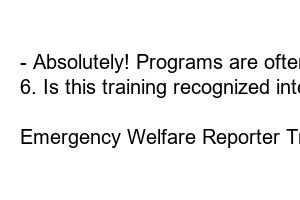긴급복지 신고의무자 교육
Title: Emergency Welfare Reporter Training: Join the Frontline in Crisis Response
Introduction:
In today’s fast-paced world, being prepared for emergencies is crucial. The significance of emergency welfare reporter training cannot be overstated. This comprehensive program equips individuals with the necessary skills to provide accurate and timely reports during critical situations, playing a vital role in crisis response.
1. What is Emergency Welfare Reporter Training?
Emergency Welfare Reporter Training is a specialized program that trains individuals to gather, analyze, and report crucial information during emergency situations. From natural disasters to public health crises, these reporters serve as a bridge between affected communities and emergency response organizations.
2. What Does the Training Cover?
This training covers a wide range of topics, including crisis communication, situational awareness, interviewing techniques, data collection, and ethics in reporting. Participants also gain insights into the importance of cultural sensitivity and understanding the needs of vulnerable populations during emergencies.
3. Benefits of Emergency Welfare Reporter Training:
By undertaking this training, you become an invaluable asset during times of crisis. You will learn how to effectively communicate critical information to the public, assist authorities in emergency management efforts, and contribute to the overall welfare of affected communities.
4. Who Should Attend the Training?
Emergency Welfare Reporter Training is open to individuals from various backgrounds and professions. Whether you are a journalist, volunteer, community leader, or simply passionate about lending a helping hand during emergencies, this training is a perfect fit for you.
5. Skills Acquired through the Training:
Participants will develop essential skills such as active listening, effective writing, data analysis, and presenting information to diverse audiences. These skills are crucial for producing accurate and impactful reports, which can significantly assist emergency response organizations in their decision-making processes.
6. Career Opportunities:
Completing Emergency Welfare Reporter Training opens doors to a multitude of career opportunities. You may find employment as a reporter for news outlets, aid organizations, government agencies, or start your own freelance reporting career. Additionally, your training can lead to other relevant roles in emergency management and public safety.
Frequently Asked Questions (FAQs):
1. How long does the training typically last?
– The duration varies depending on the training program, but typically ranges from a few days to a few weeks, including practical exercises and assessments.
2. Do I need prior journalism or reporting experience to enroll in this training?
– No, prior experience is not mandatory. The training is designed to accommodate individuals from a variety of backgrounds and skill levels.
3. Will I receive a certification upon completion?
– Yes, successful completion of the training program will earn you a certification as an Emergency Welfare Reporter, enhancing your professional profile.
4. Can I attend this training online?
– Yes, many training providers offer online courses, providing flexibility and accessibility to learners worldwide.
5. Can I join the training if I am not a native English speaker?
– Absolutely! Programs are often tailored to accommodate participants from diverse linguistic backgrounds.
6. Is this training recognized internationally?
– Yes, many training programs are internationally recognized, ensuring your skills are applicable globally.
Summary:
Emergency Welfare Reporter Training equips individuals with essential skills to effectively report during emergency situations. By gathering accurate information and aiding communication efforts, welfare reporters contribute to the overall response and recovery efforts during crises. This training opens doors to diverse career paths, nurturing individuals to become the voice of affected communities when they need it most.

